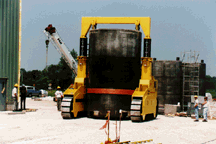Spent Fuel Storage
Dry Cask Transporter Safely Transports Spent Fuel
|
US Dept. of Energy Office of International Nuclear Safety and Cooperation 1000 Independence Ave S.W. Washington, DC 20585 (301) 903-0234 |
The Zaporizhzhya nuclear power plant in Ukraine is nearly out of space for spent fuel in its cooling ponds. The U.S. Department of Energy is working with Zaporizhzhya to establish a safe, economically viable alternative system that uses concrete dry storage casks. Through the Department's cooperative efforts, Zaporizhzhya will gain the equipment and expertise to manufacture 12 storage casks a year. Each cask will be filled with 25 spent fuel assemblies, backfilled with inert helium gas, sealed by remote control, and transported to a concrete storage pad. The casks provide both gamma and neutron shielding and have a minimum life of 40 years. Duke Engineering, the Department's prime contractor for this project, has delivered a self-propelled transporter to move casks from the loading area to the storage area. Built by J&R Engineering of Mukwongo, Wisconsin, under contract to Duke and Sierra Nuclear, the diesel-powered unit is based on commercially available heavy lift-and-haul transporters. The transporter is similar to the one used at the Point Beach nuclear power plant dry storage facility in Wisconsin.
The Zaporizhzhya transporter has a minimum turning radius of 9.1 meters (30 feet), which enables it to move in tight spaces and maneuver around obstacles. It has been adapted to lift casks from the bottom, further increasing its maneuverability in Zaporizhzhya as relatively narrow corridors. The transporter's 272-tonne (300-ton) lifting capacity is more than sufficient for the large casks that will be used at the plant. The transporter consists of a U-shaped welded carbon steel frame and platform with a track propulsion system that straddles and hydraulically lifts each cask. The lift system uses dual telescopic lifting beams with integral locking safety systems. A retaining strap secures the cask to the transporter. All functional controls are mounted on a panel at the back of the transporter deck, where the operator can see the lifting operations while operating the controls. The transporter moves casks quickly, efficiently and safely. |
